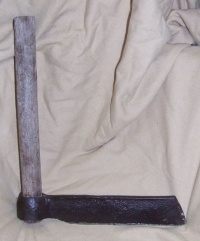Froe: Difference between revisions
No edit summary |
No edit summary |
||
| (2 intermediate revisions by 2 users not shown) | |||
| Line 1: | Line 1: | ||
[[image:froe.jpg|right|200px|thumb|Antique froe.]] |
|||
A '''froe''' is a [[woodworking]] [[tool]] that in profile looks like the letter L. One arm of the L shape is a [[wood|wooden]] handle, the other a [[metal]] [[blade]] upon which the |
A '''froe''' (also ''riving axe'' and [[17th century]]: ''lath axe'') is a [[woodworking]] [[tool]] that in profile looks like the letter L. One arm of the L shape is a [[wood|wooden]] handle, the other a [[metal]] [[blade]] upon which the bottom edge is sharpened. |
||
Froes are used for the splitting of [[wood]], usually in conjunction with a [[maul]] or [[mallet]]. The are used by placing the [[blade]] at the required section of a piece of [[wood]] and striking the back or inside edge. This drives the [[blade]] into the [[wood]] and then is levered to open up the wood and then pushed further forward or froeward. The direction of the split maybe controlled and the froe is used to create [[shingles]]. |
Froes are used for the splitting of [[wood]], usually in conjunction with a [[maul]] or [[mallet]]. The are used by placing the [[blade]] at the required section of a piece of [[wood]] and striking the back or inside edge. This drives the [[blade]] into the [[wood]] and then is levered to open up the wood and then pushed further forward or froeward. The direction of the split maybe controlled and the froe is used to create [[shingles]]. |
||
Latest revision as of 18:29, 26 March 2007
A froe (also riving axe and 17th century: lath axe) is a woodworking tool that in profile looks like the letter L. One arm of the L shape is a wooden handle, the other a metal blade upon which the bottom edge is sharpened.
Froes are used for the splitting of wood, usually in conjunction with a maul or mallet. The are used by placing the blade at the required section of a piece of wood and striking the back or inside edge. This drives the blade into the wood and then is levered to open up the wood and then pushed further forward or froeward. The direction of the split maybe controlled and the froe is used to create shingles.
The froe is now considered obsolete by modern builders and are difficult to find except in antique shops. There are a limited number of companies that produce new froes, most notably Gransfors Bruks.
